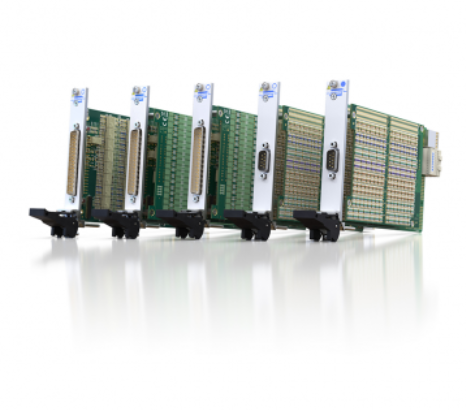Pickering Interfaces, the specialist supplier of modular signal switching and simulation solutions for use in electronic test and verification, has announced a new family of PXI and PXIe programmable resistor modules, its first that can handle up to 2A and 200V (or as limited by max power).
Part of the company’s expanding range of medium to high power resistor modules, these PXI (model 40-254) and PXIe (model 42-254) products follow on from the 2.5W (model 40-251), 5W (model 40-252), and 10W (model 40-253), providing a compact, simple solution for applications requiring one or two resistance channels, with up to 15W of power handling capability per channel. The 42-254 range is also the first medium power module available in PXIe format.
Programmable resistors are designed to simulate resistive sensors and variable resistors in systems when testing devices such as electronic controllers. The 40/42-254 family is available in a variety of resistance ranges and resolution capabilities (from 0.125Ω to 8Ω resolution and from 1Ω to 395kΩ range) to meet the needs of most functional test systems. For added test coverage, each channel can simulate short or open circuit conditions that can be experienced in a system caused by faulty wiring or sensors.
Software control is simplified by using resistor value calls. The module calculates the resistance setting closest to the requested value and sets that value. The user can interrogate the module to find the actual setting used. To help ensure long-term accuracy, a calibration cable assembly can be attached to the module in place of the UUT (unit-under-test), enabling simple calibration using a DMM (digital multimeter) to verify the resistor channels.
These resistor modules are available in 28 standard builds to suit the most common configurations:
Narrow resistance range, available in one or two-channel variants
Medium resistance range, available in one-channel variants
Wide resistance range, available in one-channel variants
Depending upon the variant, each module comprises a mother and daughterboard or a motherboard only. These are populated with resistor chains, which are switched via two-pole electromechanical relays. User connection is via a front panel male nine-pin D-type connector. For applications requiring greater density with lower power, users should consider high-density precision resistor modules (model 40/42-297A).
“Part of Pickering’s ongoing investment in simulation, these PXI/PXIe programmable resistor modules are ideal for automotive, aerospace, or medical HIL (hardware-in-the-loop) applications – as well as functional test and verification of low to medium power products such as power supplies, chargers, batteries, solar panels, and DC/DC converters,” said Paul Bovingdon, Simulation Product Manager at Pickering. “The modules’ built-in fault insertion functionality is ideal for validating against potential fault conditions. Complementing Pickering’s broader range of PXI sensor, battery, and load simulators, the modules can also be used in functional test systems to emulate actuators, coils, lamps, or auxiliary power supplies. These programmable modules offer a more flexible alternative to the hard-wired, fixed-function load resistors often found in test fixtures or custom load boards, bringing similar functionality to the modular PXI platform – but enabling multiple devices to be simulated by simply dynamically changing the amount of resistance through software.”
All standard products manufactured by Pickering Interfaces include a three-year warranty and guaranteed long-term product support.
Original article source:
FAQ
- What are Pickering Interfaces’ new programmable resistor modules?
– The new programmable resistor modules from Pickering Interfaces are devices that allow users to simulate resistive sensors or adjust signal conditioning circuits in automated test systems. They offer programmable resistance values with high accuracy and resolution, making them ideal for testing and calibrating various electronic devices.
- What is the range of resistance values that these modules can provide?
– These modules are designed to cover a wide range of resistance values, typically from milliohms to several megohms, with fine resolution steps. The exact range depends on the specific model, which is tailored to suit different applications and requirements.
- What applications are these programmable resistor modules best suited for?
– The modules are used in a variety of applications, including sensor simulation, signal conditioning, data acquisition systems, calibration of measurement devices, and any application that requires accurate simulation or adjustment of resistive loads.
- What is the accuracy and resolution of these programmable resistor modules?
– The accuracy and resolution of Pickering’s programmable resistor modules depend on the specific model. However, they are designed to provide high accuracy (often in the range of ±0.1% or better) and fine resolution, with some models allowing for step sizes as low as 0.1 ohms or less.
- How do these modules integrate with automated test systems?
– The programmable resistor modules from Pickering Interfaces are typically available in PXI, LXI, and PCI formats, making them compatible with a wide range of automated test equipment (ATE) setups. They can be easily controlled via software interfaces such as IVI drivers, allowing for seamless integration into existing test systems.
- What software support is provided for these modules?
– Pickering provides extensive software support for their programmable resistor modules, including drivers for popular programming environments like LabVIEW, LabWindows/CVI, and .NET. This ensures that users can easily integrate the modules into their automated test systems and create custom test sequences.
- Are there any safety features in these programmable resistor modules?
– Yes, safety features are often included in these modules to prevent damage to the system or the device under test (DUT). These may include overvoltage protection, thermal shutdown, and current limiting features.
